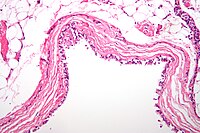
Photo from wikipedia
Endoscopic methods are increasingly used in the diagnosis of cystic lesions of the pancreas. The two major endoscopic approaches are endoscopic ultrasonography (EUS) and transpapillary diagnosis. EUS‐guided fine‐needle aspiration cytology… Click to show full abstract
Endoscopic methods are increasingly used in the diagnosis of cystic lesions of the pancreas. The two major endoscopic approaches are endoscopic ultrasonography (EUS) and transpapillary diagnosis. EUS‐guided fine‐needle aspiration cytology and EUS‐guided fine needle‐based confocal laser endomicroscopy have been used in the differential diagnosis of mucinous and non‐mucinous pancreatic cysts. EUS is the most sensitive modality for detecting mural nodules (MN) in intraductal papillary mucinous neoplasms (IPMN). Contrast‐enhanced harmonic EUS (CH‐EUS), as an add‐on to EUS, is useful for identifying and characterizing MN. Recent studies show that CH‐EUS has a sensitivity of 60–100% and a specificity of 75–92.9% for diagnosing malignant cysts. Intraductal ultrasonography and peroral pancreatoscopy are especially useful for detecting MN and IPMN. A recent meta‐analysis showed that cytological assessment of pancreatic juice using a transpapillary approach had a pooled sensitivity, specificity, and accuracy of 35.1%, 97.2%, and 92.9%, respectively, for diagnosing malignant IPMN. Further studies are warranted to determine the indications for each of these novel techniques in assessing cystic lesions of the pancreas.
Journal Title: Digestive Endoscopy
Year Published: 2019
Link to full text (if available)
Share on Social Media: Sign Up to like & get
recommendations!